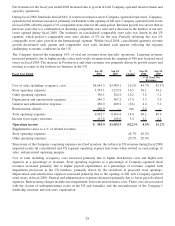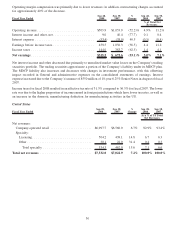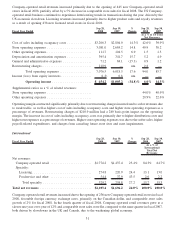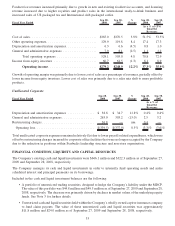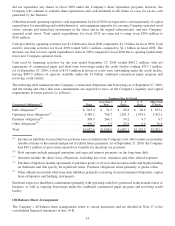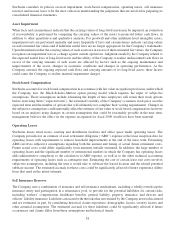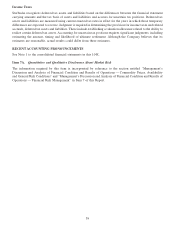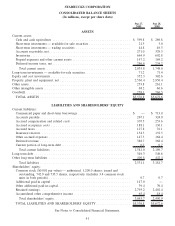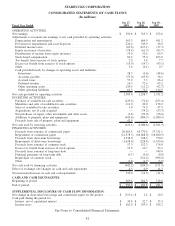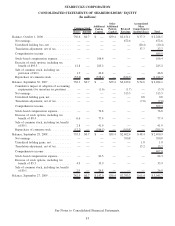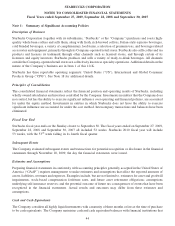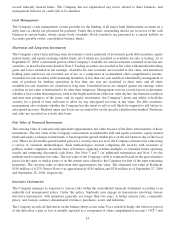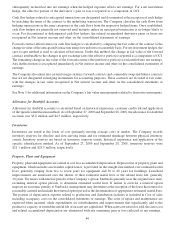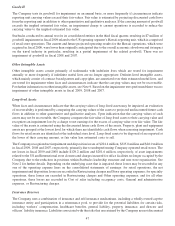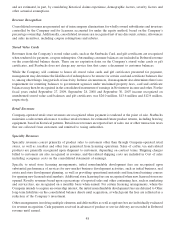Starbucks 2009 Annual Report Download - page 46
Download and view the complete annual report
Please find page 46 of the 2009 Starbucks annual report below. You can navigate through the pages in the report by either clicking on the pages listed below, or by using the keyword search tool below to find specific information within the annual report.Starbucks considers its policies on asset impairment, stock-based compensation, operating leases, self insurance
reserves and income taxes to be the most critical in understanding the judgments that are involved in preparing its
consolidated financial statements.
Asset Impairment
When facts and circumstances indicate that the carrying values of long-lived assets may be impaired, an evaluation
of recoverability is performed by comparing the carrying values of the assets to projected future cash flows, in
addition to other quantitative and qualitative analyses. For goodwill and other indefinite-lived intangible assets,
impairment tests are performed annually and more frequently if facts and circumstances indicate carrying values
exceed estimated fair values and if indefinite useful lives are no longer appropriate for the Company’s trademarks.
Upon determination that the carrying values of such assets are in excess of their estimated fair values, the Company
recognizes an impairment loss as a charge against current operations. Judgments made by the Company related to
the expected useful lives of long-lived assets and the ability of the Company to realize undiscounted cash flows in
excess of the carrying amounts of such assets are affected by factors such as the ongoing maintenance and
improvements of the assets, changes in economic conditions and changes in operating performance. As the
Company assesses the ongoing expected cash flows and carrying amounts of its long-lived assets, these factors
could cause the Company to realize material impairment charges.
Stock-based Compensation
Starbucks accounts for stock-based compensation in accordance with fair value recognition provisions, under which
the Company uses the Black-Scholes-Merton option pricing model which requires the input of subjective
assumptions. These assumptions include estimating the length of time employees will retain their stock options
before exercising them (“expected term”), the estimated volatility of the Company’s common stock price over the
expected term and the number of options that will ultimately not complete their vesting requirements. Changes in
the subjective assumptions could materially affect the estimate of fair value of stock-based compensation; however
based on an analysis using changes in certain assumptions that could be reasonably possible in the near term,
management believes the effect on the expense recognized for fiscal 2009 would not have been material.
Operating Leases
Starbucks leases retail stores, roasting and distribution facilities and office space under operating leases. The
Company provides for an estimate of asset retirement obligation (“ARO”) expense at the lease inception date for
operating leases with requirements to remove leasehold improvements at the end of the lease term. Estimating
AROs involves subjective assumptions regarding both the amount and timing of actual future retirement costs.
Future actual costs could differ significantly from amounts initially estimated. In addition, the large number of
operating leases and the significant number of international markets in which the Company has operating leases
adds administrative complexity to the calculation of ARO expense, as well as to the other technical accounting
requirements of operating leases such as contingent rent. Estimating the cost of certain lease exit costs involves
subjective assumptions, including the time it would take to sublease the leased location and the related potential
sublease income. The estimated accruals for these costs could be significantly affected if future experience differs
from that used in the initial estimate.
Self Insurance Reserves
The Company uses a combination of insurance and self-insurance mechanisms, including a wholly owned captive
insurance entity and participation in a reinsurance pool, to provide for the potential liabilities for certain risks,
including workers’ compensation, healthcare benefits, general liability, property insurance, and director and
officers’liability insurance. Liabilities associated with the risks that are retained by the Company are not discounted
and are estimated, in part, by considering historical claims experience, demographic factors, severity factors and
other actuarial assumptions. The estimated accruals for these liabilities could be significantly affected if future
occurrences and claims differ from these assumptions and historical trends.
38



